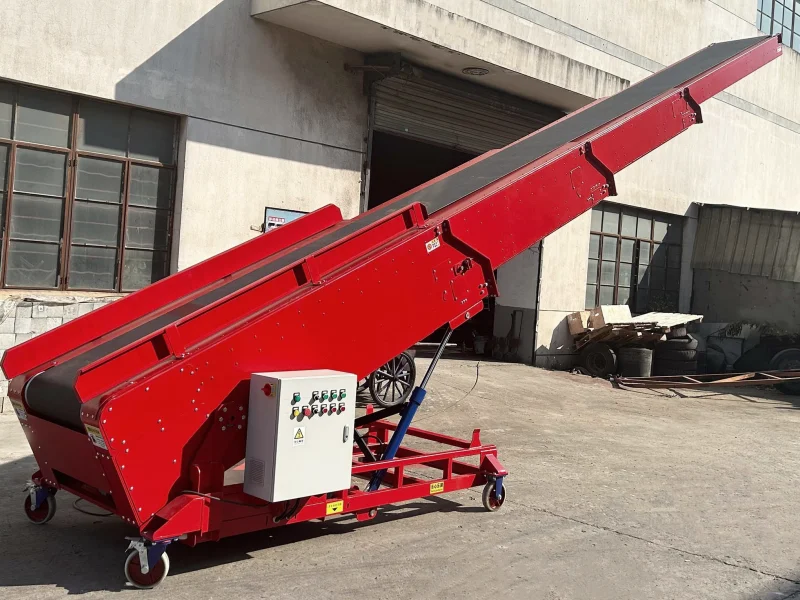
Telescopic Conveyor: an Efficient Tool for Handling Packages
In industrial production and logistics, material transportation and handling are indispensable, crucial steps. The telescopic conveyor, as a flexible and efficient tool that adapts well to various work environments, is gradually gaining popularity among companies. This article will introduce the working principle of telescopic conveyors, their application advantages, and their significant role in modern work environments.
Machine Working Principle
A telescopic conveyor is a material handling device with adjustable length based on operational needs. It mainly consists of a conveyor belt, telescoping structure, and a drive mechanism. By controlling the telescoping structure, the conveyor's length can be freely adjusted to meet the requirements of different work scenarios.
Application Advantages
- Flexibility for Various Work Scenarios: The telescopic conveyor can freely adjust its length to meet site-specific needs, adapting to different work scenarios, such as production line elevation changes and temporary material handling, thereby improving productivity and flexibility.
- Space and Cost Savings: Compared to fixed-length conveyors, the telescopic conveyor can be compressed or extended as needed, optimizing space usage and reducing construction costs, making it especially suited for tight or dynamically changing work environments.
- Enhanced Efficiency: With stable operation and a high degree of automation, telescopic conveyors enable continuous material transport, reducing manual handling and processing time, which significantly increases transportation efficiency and accuracy.
- Reduced Manual Labor: The automated nature of telescopic conveyors lessens manual labor demands, reducing worker physical strain, enhancing safety, and lowering the risk of human error.
Role in Modern Work Environments
- Production Line Automation: On production lines, telescopic conveyors enable continuous material transport without manual intervention, thereby automating the production line and enhancing productivity and product consistency.
- Warehouse and Sorting Systems: In logistics storage and sorting systems, telescopic conveyors can adjust their length based on the size and weight of various goods, quickly completing sorting and loading tasks, thus improving warehousing and logistics efficiency.
- Material Transfer and Loading/Unloading: In industrial workshops and port terminals, telescopic conveyors are adaptable to the material lengths required for different loading and unloading tasks, enabling efficient material transfer and loading/unloading operations, which boosts freight efficiency and safety.
- Temporary Work Locations: Telescopic conveyors are portable and highly adaptable, suitable for temporary work locations, such as construction sites or trade shows, facilitating quick loading/unloading and material transportation.
In modern work environments, the telescopic conveyor, as a flexible and highly automated material handling tool, plays an important role. Its advantages—such as space and cost savings, enhanced efficiency, and reduced manual labor—bring numerous benefits to businesses. Not only does it adapt to various work scenarios and needs, but it also improves productivity and flexibility, conserves space and construction costs, and reduces manual labor intensity.
Additionally of telescopic conveyors
- Multi-Functional Applications: Telescopic conveyors are suitable for transporting various materials, such as luggage, paper, food, and electronics. Their flexible length adjustment and automated control allow them to handle materials of different shapes and sizes.
- Application in Logistics and Warehousing: Telescopic conveyors can integrate with warehousing equipment, enabling automation in tasks such as loading, transportation, sorting, and unloading, thus improving logistics efficiency and reducing errors caused by human factors.
- Application on Assembly Lines: Telescopic conveyors can adjust their length and height according to the different processes and requirements on an assembly line, conveying components and raw materials to various work areas, facilitating assembly operations and boosting the production line's capacity and quality.
- Application in Airports and Port Logistics: Telescopic conveyors can be used in luggage transport and cargo loading/unloading, adapting to various material sizes and weights, thus enhancing efficiency and logistics speed.
- Application in Temporary Work Locations: Telescopic conveyors are easy to move and install, making them suitable for temporary workplaces, such as temporary warehouses or construction sites, ensuring more convenient and efficient material transport and handling.
As a flexible and efficient tool that adapts to various work environments, the telescopic conveyor has a broad range of applications and plays a critical role. By optimizing material transport and handling methods, it improves productivity, reduces labor requirements, and provides businesses with more efficient, convenient, and sustainable logistics solutions. With continuous technological innovation and expanded applications, telescopic conveyors hold great development potential and are expected to play an increasingly important role in modern work environments.


Leave Me Your Requirement!